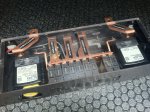4RunAmok
Explorer
If you are using a solenoid as stated in the beginning of the thread and had, for some reason, a dead house battery. Once started, wouldn't the system want to equalize the batteries causing a rapid drain from the start battery, perhaps overloading the system, assuming 4ga wire, 200A solenoid with 120A ANL fuses?
What would be the merits of a battery isolator like this?
View attachment 192437
Sorry if this has been asked and answered, I missed it.
There are no merits to an isolator of this type. These are Diode isolators, which will reduce voltage coming from the alternator/charging source, and neither battery will ever receive a full charge as a result.
What you mention about pairing the batteries when the aux battery is very low is a real situation, which is why you would want to use your accessory wire to engage the solenoid and NOT your ignition wire. The result is "Start Isolation". Accessory loses power when the key is in the start position, thus separating the batteries during start up. And regarding the aux battery being very low, that's why you want a large fuse and large wire.




